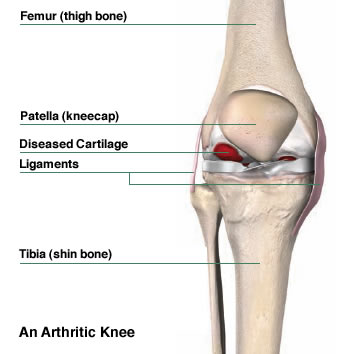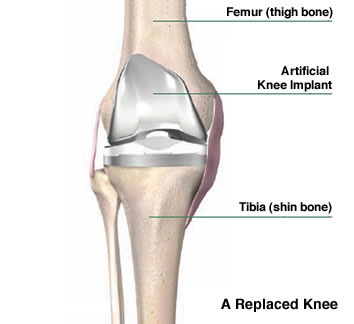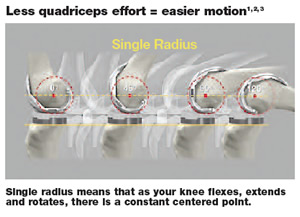Total Knee Joint Replacement
Are You Considering Knee Replacement Surgery?
Every year, millions of knee replacements are performed across the United States. Total knee replacement surgery is a common surgical procedure in which certain parts of an arthritic or damaged knee joint are removed and replaced with an artificial joint called a prosthesis. The prosthesis is usually made from plastic, metal, or ceramic and is designed to allow the artificial joint to move with ease, comfort, and stability.
Knee Basics & Anatomy
Knee Anatomy and Function
The knee joint is one of the largest and most complex joints in the human body. A hinge joint, the knee joint allows the leg to extend and bend with minimal side-to-side motion. The knee connects the thigh bone (femur) and shin bone (tibia) to each other. The kneecap and the fibula, the smaller bone next to the tibia, also make up the knee joint. Numerous fluid-filled sacs called bursae surround the knee joint, which helps the knee move smoothly.
The bones comprised in the knee joint meet at the bottom of the femur, the top of the tibia, and the back of the kneecap. Articular cartilage covers these surfaces where the bones meet. Articular cartilage is a slippery, strong, flexible material that provides cushioning and lubrication for the knee joint. Articular cartilage acts as a shock absorber and essentially allows the bones to smoothly the glide over each other when in motion.
Arthritis: The Leading Cause of Knee Pain
Inflammation, pain, inactivity, and lifestyle factors can cause extreme tiredness and fatigue, especially when you live with arthritis. As we age, our joints can experience what is called natural wear-and-tear. Over the years, the cartilage and connective tissues in our joints can deteriorate. This deterioration can cause our joints to be stiff or inflamed. Without connective tissues or cartilage, the joint no longer has the cushioning or lubrication it needs to move and perform properly.
The knee joint is most commonly affected by arthritis of the knee. Patients who have severe arthritic conditions or joint-related injuries are the most common candidates for total joint replacement surgery. Sometimes, people living with arthritis and related conditions can experience different types of pain at the same time. That’s why it’s important to work with your health care provider to develop the best knee solution plan for your specific needs.


Knee Replacement Surgery in Fort Myers, Estero and Naples
Total joint replacements have been performed since the 1960s and have changed the lives of millions. Today, these procedures have been found to result in significant restoration of function, as well as have helped reduce joint stiffness and pain for millions of patients across the country. Knee replacement, hip replacement, and shoulder replacement are some of the most common joint replacement surgeries performed at the Orthopedic Center of Florida in Fort Myers, Estero and Naples.
There are significant potential benefits of replacing an injured or diseased knee:
- Joint pain is drastically reduced or completely eliminated
- Mobility is greatly improved or completely restored
- The artificial will continue to perform, as intended, for several years
Knee Implants That Promote Easier Motion
In a total knee replacement, the diseased or injured joint is replaced with an artificial joint. The artificial joint, or prosthesis, is then anchored into place to ensure stability and durability. Different knee doctors may have different methods of anchoring the prosthesis into place, but this anchoring is typically done so with bone cement or a medically-advanced material that allows bone tissue to grow into the prosthesis.
Stryker Knee Replacement
Stryker Knee Replacements are designed specifically to increase a patient’s range of motion. Stryker Knee Replacements have a single radius design, allowing the implanted knee to mimic natural range of motion and requiring less effort from your thigh muscles (quadriceps). The accessibility of cutting-edge materials, such as titanium and ceramic prostheses and plastic joint liners, gives our Fort Myers, Estero and Naples knee surgeons better options that will assist in increasing the longevity of the prostheses. Ongoing advancements in surgical techniques and instrumentation such as this will help your treatment become even more successful.
Stryker Knee Implants are Designed to Last Longer
Though conventional artificial joints have been highly successful over the years, they can become unstable, requiring patients to undergo revision surgery. Because of this, and the fact that more active, younger patients require joint replacements and older patients are living longer, the orthopedic industry has made great strides in extending the life cycle of prosthetics. Designed with advanced bearing surfaces and balance, Stryker knees are customized to your unique anatomy, resisting wear and excessive stress in any one spot. Stryker’s Advanced Bearing Technology has a success rate of 96% compared to competitive premium bearing technologies.


What Typically Happens During Surgery
The surgeon will first make an incision on the front of the knee and proceed to cut through the tissue surrounding the knee. The kneecap (patella) is then rotated to the outside of the knee so the knee doctor can properly place the implant. Using specialized cutting instruments, the surgeon will make precise cuts of the bone. The thigh bone (femur) is then cut into a shape that matches the corresponding surface of the metal femoral component. The femoral component, placed on the end of the femur, replicates the anatomy of the distal femur, which keeps your patella securely in place.
The knee specialist will cut the top of the shin bone (tibia) where the exposed end will be sized to fit the tibial components. The metal tibial component is inserted into the bone, and a plastic insert is attached to it. As the patient bends the knee, the femoral component will slide on this plastic insert, providing smooth and comfortable motion. To help further secure the knee implant to the bone, bone cement may be used. Finally, your surgeon will suture the incision site, completing the knee replacement surgery.
Risks Associated with Knee Replacement
Knee replacements, like any major surgery, have associated risks. Though the complication rate is less than 2%, patients who undergo total knee replacement surgery are at risk of complications such as infection, blood clots, heart attack, stroke, nerve damage, lung congestion, and Pneumonia.
The vast majority of these complications can be successfully avoided or treated by a trained medical professional. Talk to a knee specialist at the Orthopedic Center of Florida in Fort Myers, Estero and Naples for a complete assessment of the potential risks.
Life After Knee Replacement
After knee surgery, there are many things you must do to ensure a safe and successful recovery. Immediately following surgery, you will begin physical therapy to strengthen the muscles around your new and improved knee.
After your knee replacement and physical therapy are completed, you will be ready to start living your life to its fullest. When you’re fully recovered, most patients can expect to return to work, unless stated otherwise. Our knee replacement patients are encouraged to start moving again as soon as possible after surgery.
Millions of people undergo joint replacement surgery every year with incredible success. Not only do knee replacement patients experience reduced joint pain and stiffness, but they also have significant improvement in their range of motion, strength, and ability to perform daily activities.
Your orthopedic surgeon will recommend the appropriate level of activity for you and your specific needs. During your appointment, you can speak with your doctor about how to safely regain mobility and flexibility after your knee replacement surgery.
Don’t Let Knee Pain Slow You Down
You don’t have to live with severe knee pain and the limitations it may put on your activities. If you haven’t experienced adequate relief with medication or other conservative treatments, knee replacement surgery may provide relief from pain and enable you to return to your favorite activities. If conservative treatments have not offered you any relief, our knee replacement solutions may provide you with the pain relief you need.
The Orthopedic Center of Florida can help you become one of the millions of people across the country who have had a successful and life-changing knee replacement. It’s our job to help treat your acute and chronic pain so you can comfortably function in everyday life.
For more information, contact Orthopedic Center of Florida or schedule online for a consultation in our Fort Myers, Estero or Naples, FL offices.
Stryker Corporation or its divisions or other corporate affiliated entities own, use or have applied for the following trademarks or service marks: Stryker and X3. All other trademarks are trademarks of their respective owners or holders.
References:
1. National Institutes of Health Consensus Development Conference Statement: Total Knee Replacement 12/10/03.
2. AAOS website, http://orthoinfo.aaos. org/topic.cfm?topic=A00385, accessed April 2011.
3. AAOS website, http://orthoinfo.aaos. org/topic.cfm?topic=A00385, accessed April 2011.
4. Ostermeier, S; Stukenborg-Colsman, C, Hannover Medical School (MHH) Hannover, Germany ‘Quadriceps force after TKA — a comparison between single and multiple radius designs,” Poster No. 2060 • 56th Annual Meeting of the Orthopaedic Research Society.
5. Harwin, S.F., Hitt, K, Greene, K.A. Early Experience with a New Total Knee Implant: Maximizing Range of Motion and Function with Gender-Specific Sizing Orthopedic Surgery, Surgical Technology International, XVI. pgs 1-7.
6. Greene, K.A. Range of Motion: Early Results from the Triathlon® Knee System, Stryker Literature Ref #LSA56., 2005.
7. Wang, H., Simpson, K.J., Ferrary M.S., Chamnongkich, S., Kinsey, T, Mahoney, O.M., Biomechanical Differences Exhibited During Sit- To-Stand Between Total Knee Arthroplasty Designs of Varying Radii, JOA, Vol. 21, No. 8, 2006.
8. Stryker Orthopaedics Test Report: 06-013.
9. The effect of total knee arthroplasty design on extensor mechanism function, JOA, Vol. 17, Issue 4, June 2002, pp. 416-421.
10. Hanssen, A.D., et al., ‘Evaluation and Treatment of Infection at the Site of a Total Hip or Knee Arthroplasty,” JBJS, Vol.80-A, No. 6, June 1998, pp. 910-922.
